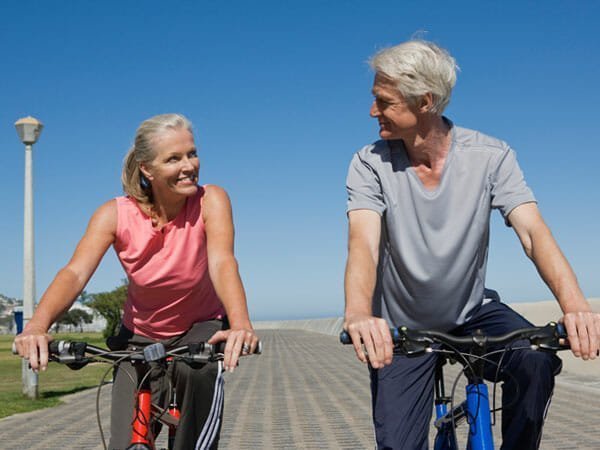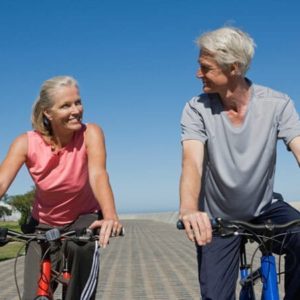
Healthy Aging with a Little Help from Your Intergenerational Friends
Healthy Aging with a Little Help from Your Intergenerational Friends
 Healthy aging is an important part in being able to live your life to its fullest. We all want to stay as fit and sharp minded as possible so we can continue to enjoy the activities we love doing. Below is an article where therapist Karen Peterson explains just how we can achieve the goal of healthy aging.
Healthy aging is an important part in being able to live your life to its fullest. We all want to stay as fit and sharp minded as possible so we can continue to enjoy the activities we love doing. Below is an article where therapist Karen Peterson explains just how we can achieve the goal of healthy aging.
Eye-Brain-Body Therapy with a Partner Improves Balance for Seniors;
Nonprofit Founder Reviews Benefits
Two major areas connected to overall health that are too frequently overlooked, particularly for those aged 65 and older, are visual capability and social connectedness, says therapist and charity innovator Karen Peterson.
“Physical and mental attributes are intimately connected, and what many do not realize is that balance is 20 percent based in vision. There are multiple ways of testing this, but perhaps the most simple is to stand on one leg, and then try to do so with your eyes closed – when your eyes are closed, you vestibular system, which controls your body’s balance, begins to work overtime,” says Karen Peterson, a therapist with multiple certifications, and creator of the new book and video series, “Move With Balance: Healthy Aging Activities for Brain and Body,”. She’s also the founder and director of Giving Back, a nonprofit organization that grows and spreads programs that support senior health.
“Seniors of all ages – 55 to 105 – need to continually work on improving their balance, coordination, strength, vision and cognitive skills,” says Peterson, who has been teaching vision, brain and kinesiological modalities to children, businesspeople, athletes, classroom teachers and adults of all ages since 1987. “When they do, they’re less likely to fall and more able to enjoy life.”
In 2005, she expanded her program to focus on elders; specifically, to encourage active and younger seniors to buddy up with frail elder seniors for exercising eye-brain-body connections.
“Some folks reach a milestone age and recognize that they need to get active and, after only a short while, they actually feel younger. It’s these folks who we’ve encouraged to mentor other seniors who haven’t taken that step,” Peterson says.
“Members from different generations have partnered in training, and it’s an interesting learning experience for both parties.”
Peterson reviews the benefits of paring with a training buddy while practicing exercises that facilitate eye-brain-body cohesion:
• Independent study: Performed by a registered nurse and Dr. Lorrin Pang, Director of the Maui District Health Office, the Moving With Balance program, headquartered in Hawaii, has provided plenty of positive data. The objective is to reduce the number of falls in elderly who are institutionalized, many with cognitive deficits. The study was designed to compare the number of falls in the group doing the Move With Balance exercises to the number of falls in those serving as controls (no exercise). While the multiyear study is in the peer-review process, data shows a statistically significant reduction in falls in the target group – 38 percent.
• The importance of vision exercise: Vision gives the nervous system updated information about the position of body parts in relation to each other and the environment. With that information we judge distances, avoid obstacles and control our balance. Visual information goes directly to the midbrain, where it becomes part of the sensory motor pathway. This information lets us know and control where we are in space. When people get old, they tend to lose their control of this seeing-based system that provides spatial orientation. With one in three seniors experiencing a significant fall this year, visual-spatial exercises are an important measure for prevention.
• One example of a visual integration exercise – the arrow chart: With a partner holding the chart, look at the arrows and call out the direction indicated by each individual symbol. Then, thrust your arms in that direction; in other words, say and do what the arrow indicates. A partner can verify or correct movements. For an additional challenge, do the opposite of what the arrow indicates.
• Help from your friends: Working with a partner is tremendously beneficial for many of these exercises. Not only does it help with structure, consistency of schedule and morale, many of Peterson’s exercises call for coordinated movements and fast reaction times, including ball tosses. Partners can help cue and coach, and they provide security for seniors afraid to challenge themselves for fear of falling.
Successfully executing of these exercises indicates good brain processing ability, which is necessary for cognitive skills and balance, Peterson says.
About Karen Peterson
Karen Peterson is founder and director of Giving Back, a nonprofit organization dedicated to improving the lives of elders through intergenerational mentoring. She has multiple certifications, including as a educational kinesiologist, natural vision improvement instructor, Touch for Health instructor and a massage therapist. For 27 years, Peterson has been teaching these modalities to children, businesspeople, athletes, classroom teachers and adults of all ages and occupations.
Receive your complimentary Relocation guide and magazine

